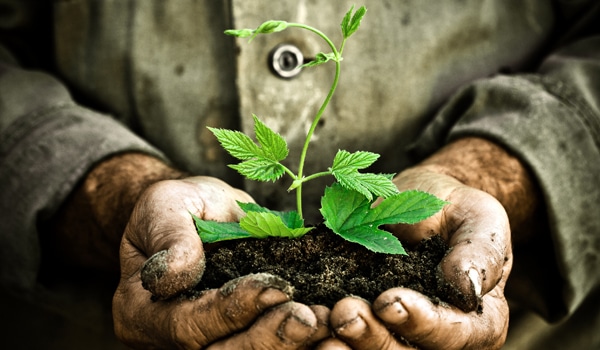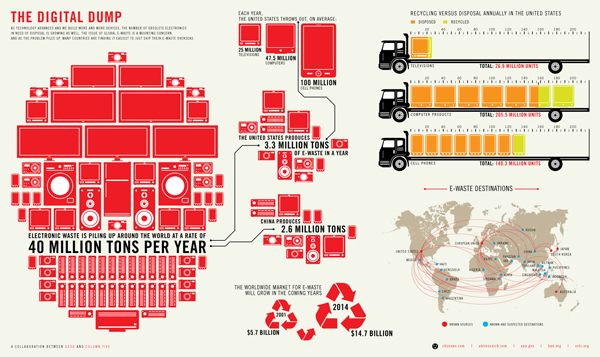I bet my mom still has the thickly bound project I turned in for a grade 8 assignment on acid rain.
I can remember the cover clearly; “It’s Raining Cats and Dogs”, it said, and I spent hours lovingly illustrating and colouring it with my giant box of Laurentian pencil crayons. As I carefully blended colour upon colour, I thought about fossil fuels and pH balance and dying forests and sick fish.
I thought about the impact that my grade 8 self was having on those forests and fish.
And I made a choice to do better.
I suppose that’s what we call a ‘formative moment’ since today I still think about dying forests and sick fish, and I still try to do better where I can.
And while acid rain is no longer the affliction it was in the 80s, it and many other socially charged issues face us. As individuals. As organizations and institutions and governments.
In the electronics industry, for example, legislation continues to emerge from countries around the globe. Technology is evolving so rapidly and the demand for the ‘latest and greatest’ so high that many electronic products become obsolete seemingly overnight.
As a result, landfills are overflowing with electronic waste, and the chemicals therein. (It would be remiss of me not to state explicitly here that Creation’s environmental policy accounts for the safe and responsible disposal of all electronics and chemicals).
How much waste, you ask?
A whopping 40 million tonnes each year, if you can believe it.
The intent of each of the emerging environmental regulations is the same – take aim at this electronic waste and its effect on the health of our communities at large. The reality is that their divergent implementation processes and requirements are having an adverse effect.
But, (with thanks to those groups actively working toward the establishment of globally harmonized environmental policy), I digress.
What I really want to say is that it’s easy to choose to do better. Even if it’s just a little bit at a time.
And what better day than Earth Day to begin to do that little bit better?
Occurring each April since 1970, Earth Day is a day to reflect on our impact on the earth, our local ecosystem and the environment in general. It’s also a day to take action.
In 2013, it’s estimated that more than 1 billion people in 192 countries are participating in Earth Day.
Like Kermit says, sometimes it’s not easy being green.
http://www.youtu.be/yKoLBSK8SSE&w?rel=0
So to help you be one of the 1 billion, here are some simple Earth Day tips. To help you avoid stopping at Earth Day, there’s one for you try each week for a year.
Try making just one new change or adding one new habit or resolve each week. Share your favourite tips with your friends and family. You’ll be surprised at the impact you’ll have.
What are your favourite Earth Day tips? Please share them in the comments!
52 Green Tips for Earth Day
Save on Gas
- Walk, cycle or use public transportation.
- Organize a carpool.
- Don’t be a lead foot. Avoid aggressive driving as rapid acceleration and braking can decrease gas mileage.
- Check your tire pressure at least twice a month and add air when needed. Not only will your car handle better, but under-inflation increases tire wear, reduces your fuel economy by up to 3% and leads to higher greenhouse gas emissions and releases of air pollutants. If you don’t know the correct tire pressure for your vehicle, you can find it listed on the door to the glove compartment or on the driver’s-side door pillar.
- Check your owner’s manual to see what maintenance you might have skipped. A well-maintained car is more fuel-efficient, produces fewer greenhouse gas emissions, is more reliable, and is safer! Also check and replace your vehicle’s air filter regularly.
- If it’s clear that a train or other barrier will block your vehicle for more than 30 seconds, turn off the engine. An idling vehicle burns more fuel than a simple restart. And you won’t be polluting when the engine is off.
Change How You Think About Food
- Consider where your food comes from (buying locally where possible) and try to alter your menu to buy seasonal foods. The average meal travels 1,200 miles from the farm to your plate. Buying locally will save fuel and keep money in your community.
- Buy fresh instead of processed foods, which require more energy to produce, starting from extraction, manufacturing, transport, advertising and marketing.
- Don’t use straws for drinks and shakes.
- Do not buy bottled water.
- Buy organic foods as much as possible. Organic soils capture and store carbon dioxide at much higher levels than soils from conventional farms. If we grew all of our corn and soybeans organically, we’d remove 580 billion pounds of carbon dioxide from the atmosphere!
- Eat less meat. Methane is the second most significant greenhouse gas and cows are one of the greatest methane emitters. Their grassy diet and multiple stomachs cause them to produce methane, which they exhale with every breath.
- Avoid eating fish such as monkfish, farmed Atlantic salmon, bluefin tuna, orange roughy and others that have low populations, poor management of stocks, habitat damage and over-fishing. A full list of these fish can be found at www.seachoice.org.
Save a Tree
- Read your daily dose of news online.
- Work digitally whenever possible. Stop printing, but if you must, print double-sided.
- Buy recycled paper products. It takes less 70 to 90% less energy to make recycled paper and it prevents the loss of forests worldwide.
- When you’ve finished reading the latest issue of your favourite magazine or other periodical, don’t toss in it in the recycling box (and definitely don’t throw it in the trash)! Instead, drop it off at your gym, office, local gathering spot, or swap it with a friend.
- Use a reusable ‘canvas’ shopping bag. Avoid use of plastic shopping bags.
- Plant a tree. A single tree will absorb one ton of carbon dioxide over its lifetime.
- If using solid wood for a renovation project, select products with the Forest Stewardship Council label, certifying the wood was responsibly grown and harvested. Or find salvaged wood products at local used-building materials retailers.
- Dimensional lumber that is 2-by-10 and larger often comes from increasingly rare old-growth forests. So for larger lumber and beams, consider engineered materials made of wood harvested from faster-growing tree species and glued together to form a finished product. These products often perform better than solid-sawed wood, which is subject to warping, splitting and cracking.
Stop Pollution, Protect Your Health
- Avoid the store-bought air fresheners and purifiers (including the ones with a “natural” or “green” label) that actually leech toxins into the air you and your family breathe. Common ingredients include phthalates (linked to birth defects) and VOCs (linked to kidney damage, liver damage and damage to the central nervous system including the brain). Scary, right?
Instead, try simmering cinnamon, orange peel, and cloves on the stove. It’ll give your home the fresh smell of, well, cinnamon, orange peel and cloves. - Use baking soda or vinegar with lemon juice in small dishes to absorb odours around the house.
- To create a tub-scum cleaner, mix baking soda and a “green” liquid soap to a honey-thick consistency. Apply it with a little elbow grease and perhaps a splash of white vinegar.
- Plain water on a cloth works great for the vast majority of dusting chores. If in need of something more powerful, choose the least-toxic product for the job at hand.
- Reduce your garbage. Can you reuse the item you are about to throw away? If not, what about someone else?
- Do not idle your car.
- Dispose of toxic chemicals appropriately. For example, mercury is present in small quantities in fluorescent bulbs, and in larger quantities in older thermostats and some light switches.
These items must be disposed of at a hazardous waste collection site. - Choose low-toxic paints that also are low in volatile organic compounds, or VOCs, which convert to gas at room temperatures. Outdoors, certain VOCs react with sunlight to create smog. Indoors, VOCs can irritate lungs and cause allergic reactions. Check the paint label for a VOC level below 150 grams per liter. Zero-VOC paints also are available.
- The common household cleaners under our sinks contain many chemicals that are proven to be associated with chronic, or long-term, effects such as cancer and hormone disruption. And that lovely, “fresh” smell? The National Institute of Occupational Safety and Health found that 30% of the substances used in the fragrance industry are toxic, but because the chemical formulas of fragrances are considered trade secrets, companies aren’t required to list their ingredients but merely label them as containing “fragrance.”Ready to try an alternative?
- For an all-purpose cleaner, mix vinegar and salt for a good surface cleaner. Pour some baking soda and vinegar on a damp sponge. It will clean and deodorize all kitchen and bathroom surfaces.
- To clean your windows, mix equal amounts of water and vinegar in a spray bottle. Wipe the glass with newspaper for a streak-free shine.
- To polish your faucets? Use cucumber! (Yes, really). Rub cucumber on the surface to clean the area and bring back shine by removing years of tarnish.
- Find more good ideas like these here: http://eartheasy.com/live_nontoxic_solutions.htm
Water Conservation
- Shorten your shower time, turn off the tap when soaping and don’t use more water than you need.
- Turn off the tap while brushing your teeth.
- Try not to water your lawn.
- Choose a dual-flush toilet.
Energy Conservation
- Install a programmable thermostat that lets you automatically lower the temperature when no one is home or when the family is asleep. According to Energy Star, this can save up to $150 a year.
- Only run your dishwasher when there’s a full load and use the energy-saving setting.
- Refrigerators and freezers account for almost 20% of a home’s energy use, so select energy-efficient models when buying a replacement.
- Unplug your computer, television, stereo, microwave, cell phone charger and other electronic appliances and gadgets instead of just turning them off. Save an average of $90 a year by shutting down a home computer every night.
- Avoid air purifiers and fresheners as well as insect repellents that plug into electric outlets.
- If you need a new computer, buy a laptop if you can. A laptop uses just 25% of the power required by a desktop computer.
- Use cold water for your laundry. It can save up to 80% of the energy required to wash clothes.
- Plant a tree that will shade your house as well as reduce the need for air conditioning. Shade provided by trees can also reduce your air conditioning bill by 10 to 15%.
- Insulate and weatherize your home. Properly insulating your walls and ceilings can save 25% of your home heating bill and 2,000 pounds of carbon dioxide a year. Caulking and weather-stripping can save another 1,700 pounds per year.
- The average home contains two televisions, a DVD player and three phones. These home electronics can use more energy than you think. As you replace existing equipment, look for Energy Star models that help reduce carbon emissions.
- Turn off the lights when you’re not in the room!
- Turn off your pilots on your furnace if and when you do not need to heat your house.
- Turn off the pilot on your water heater when you go on vacation.
- Set up a ‘charging station’ for equipment that needs charging — plug everything into a power bar and turn that off until you actually need to charge something.
- Replace incandescent light bulbs with Compact Fluorescent Light Bulbs (CFLs) or LEDs.
- Turn down your water heater.
- Turn down your thermostat.
- Always recycle. It’s a no-brainer. One of the easiest ways to ‘go green’ is to recycle your waste. If you’re entertaining, make it easy for your guests to recycle, too.




